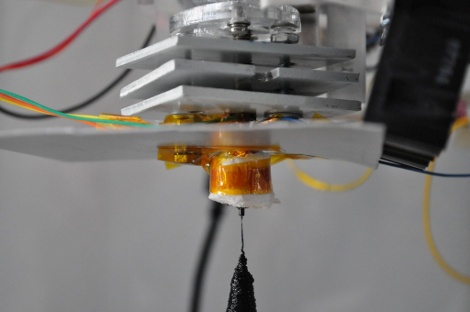
Imagine if you will for a moment, you’re printing along on your Makerbot clone and all of a sudden your PTFE hot end melts, what are you going to do now? One solution is to mill your own all metal end from a bolt with some careful drilling. Or you could follow [Peter Jansen] who has made his own all metal hot end using the existing extruder. All that’s required is some aluminum sheet and cutting down the nozzle and hat (and fans to help, but technicalities), and you’re in business with no more melted PTFE hot end.
















“Imagine if you will for a moment, you’re printing along on your Makerbot clone and all of a sudden your PTFE hot end melts”
I dont have a maker bot, never seen one in real life and have not clue what a PTFE hot end is or why one would be using something that could melt in the first place
@osgeld: I share your background, or lack thereof, but google tells me PTFE is Teflon(TM). It also tells me that that stuff has a melting point of 327 degrees C, so if temperature regulation in your hot end is lacking, I guess that might be problematic.
As for what a hot end is, it doesn’t take much guessing to figure that it is probably the part where the melted plastic comes out.
it could also mean a hooker with a bottle of Tabasco sauce, but your probably right
point was don’t assume everyone here has these things and automatically know wtf your talking about
and I generally don’t do research when I am imagining (maybe later to make it practical but not during)
I have a printer based on that machine’s design.
The PTFE becomes malleable as it approaches its melting point, so even though the machine whould NEVER be going over 250C, the PTFE sleeve that carries non-molten plastic filament to the heated part of the extruder can warp.
If/when it warps (lost four to this myself) the plastic begins to leak out of the PTFE tube and does so by pressing it outwards and expanding into the threads of the heater barrel and then out of the enclosure entirely.
This can also be fixed to some degree with a copper sheath and a pipe clamp.
This system aims to cool down the heater barrel rapidly and in a localized way, so as to produce the shortest thermal gradient possible.
I thought they came out with a cream in the 50’s that solved the “hot end” problem.
Doesn’t PTFE release some really seriously gnarly fumes when it gets to that temperature?
If your extruder is PTFE, you’d better keep your birds outside the house or they’ll die.
PTFE begins to release gasses at high temps, yeah.
http://www.fluoridealert.org/pesticides/teflon.decomposition.prod.htm
If you are running the PTFE at 250C, you’re doing it wrong.
which brings me back to one original point, there has to be something better out there than what they are using, yea ok so one poster says it melts at 350c, these machines run ~250c that is not that much of a difference in the big picture, as another poster pointed out it starts to get soft and cause problems, hince THIS hack. but still soft fumy plastic doesnt sound like the best choice
discuss : )
osgeld,
I’m generally in agreement. I think there has to be a better material, but I’m at a loss for what that might be.
PEEK?
http://www.machinist-materials.com/comparison_table_for_plastics.htm
what is the advantage of using plastic at all, why not metal? would a quarter inch of steel rod with a hole in it heatsink that much?
@osgeld
You’re absolutely right. It’s basically a hot glue gun anyway.
@octel
I wonder if anyone has made a 3D printer using a hot glue gun yet…
@myself
Appears so. No build log or anything, but still:
http://blog.rebang.com/?p=101
@Squirrel
That was like, the first reprap prototype’s extruder system.
Hot glue is expensive and not very strong.
PEEK is in use among many rep-rappers.
Currently the reprap/makerbot/bfb/shapercube/whatever universe looks like this:
PEEK for ABS plastic at 225-250C
PTFE for PLA plastic at 180-200C
Metal for anything 250-300C
The primary purpose of the PTFE/PEEK tube is to act as an insulator, as in many printers the parts right above that hot nozzle are parts the nozzle once printed! You have to disperse or otherwise obstruct more than 250C, or your machine will melt itself.
In the case of the makerbot, acrylic is used for the motor block. If it gets got it can melt, warp, and generally muck things up. It’s also important to note that the extruder controller board is mounted right above this as well, so rising hot air can sometimes make the board overheat and power off in the middle of a print.
ah, thanks for clearing that up
what if i want to use a controlled thermite reaction to extrude not plastic, but molten iron from my ‘makerbot’
then you use an asbestos nozzle obviously!
Which link is the link to the discussed project? I guess it’s ‘Imagine’? This is a terrible choice of linked text.
The hot melt adhesive industry uses a brass nozzle with a stainless steel insert in a variety of diameters and length (called engagement) to suit the demands of the application. There are other nozzle types but that’s generally the combination used. A nozzle of this type would suit this application extremely well.
The least expensive aftermarket standard nozzles are around $10 US, too.
http://www.hotmeltnozzles.com